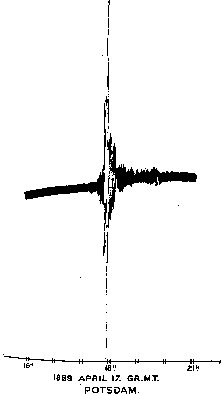17th April marks the 125 anniversary of the first ever recorded seismogram from a distant earthquake. The widely recognised first teleseismic seismogram was recorded on April 17, 1889, in Potsdam, Germany by E. von Rebeur-Pacshwitz (Nature, 1889). The earthquake was in Japan and had a magnitude of about 5.8. Ironically the instrument was originally installed for astronomical purposes. The instrument consisted of a photographical recording horizontal pendulum.

During the three months from April to June, the disturbance of April 17, i8h. G.M.T., was the most remarkable which occurred The following readings of Greenwich mean time, which are best explained by the accompanying figures, are taken from the original photographs ; it must, however, be mentioned that the small scale of 11 millimetres per hour does not allow a very accurate determination of time, and that an error of one minute or two is quite probable. (Nature, 1889)
A response to the published article by Cargill G. Knott featured in the subsequent issue
DR. VON REBEUR-PASCHWITZ’S letter, which appeared in NATURE, vol. xl. p. 294, is of special interest to us in Japan, countenancing as it does the conjecture that the very peculiar earthquake felt and registered here on April 18 was the result of a disturbance of unusual magnitude. It was my good fortune on the day in question to be engaged in conversation with Prof. Sekiya in the Seismological Laboratory at the very instant the earthquake occurred. We at once rushed to the room where the self-recording instruments lay, and there, for the first time in our experience, had the delight of viewing the pointers mark their sinuous curves on the revolving plates and cylinders. At first sight it seemed as if the pointers had gone mad, tracing out sinuosities of amplitudes five or six times greater than the greatest that had ever before been recorded in Tokio …
(Nature 1889)
Despite that this popular scribble is considered as a first, one also has to acknowledge that other scientists where trying to develop similar instruments during that same and previous years. The earliest known seismogram is of February 23, 1887, recording a large earthquake which occurred in the French-Italian border region. The seismograph was a Cecchi instrument located at Moncalieri, Italy. This instrument is considered to have had a weak sensitivity.

Seismogram (east-west component) obtained by a Cecchi seismograph at Moncalieri, Italy, on February 23, 1887.
Over the following years a rapid number of seismographs where installed across the globe, which together with theoretical progress in the understanding of elastic behaviour in solids, led to the modern era of seismology and the understanding of our planet’s interior.
Follow an interesting read dedicated to The Early History of Seismometry (to 1900) by James Dewey and Perry Byerly.
